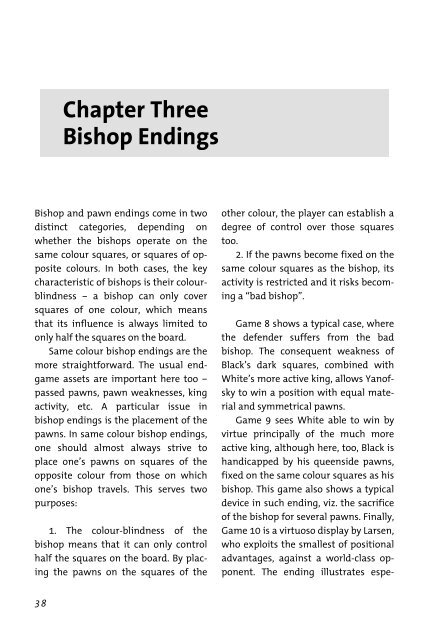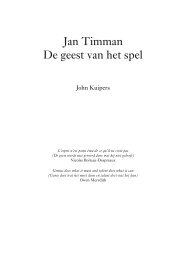Download sample pages. (pdf) - New In Chess
Download sample pages. (pdf) - New In Chess
Download sample pages. (pdf) - New In Chess
You also want an ePaper? Increase the reach of your titles
YUMPU automatically turns print PDFs into web optimized ePapers that Google loves.
38<br />
Chapter Three<br />
Bishop Endings<br />
Bishop and pawn endings come in two<br />
distinct categories, depending on<br />
whether the bishops operate on the<br />
same colour squares, or squares of opposite<br />
colours. <strong>In</strong> both cases, the key<br />
characteristic of bishops is their colourblindness<br />
– a bishop can only cover<br />
squares of one colour, which means<br />
that its influence is always limited to<br />
only half the squares on the board.<br />
Same colour bishop endings are the<br />
more straightforward. The usual endgame<br />
assets are important here too –<br />
passed pawns, pawn weaknesses, king<br />
activity, etc. A particular issue in<br />
bishop endings is the placement of the<br />
pawns. <strong>In</strong> same colour bishop endings,<br />
one should almost always strive to<br />
place one’s pawns on squares of the<br />
opposite colour from those on which<br />
one’s bishop travels. This serves two<br />
purposes:<br />
1. The colour-blindness of the<br />
bishop means that it can only control<br />
half the squares on the board. By placing<br />
the pawns on the squares of the<br />
other colour, the player can establish a<br />
degree of control over those squares<br />
too.<br />
2. If the pawns become fixed on the<br />
same colour squares as the bishop, its<br />
activity is restricted and it risks becoming<br />
a “bad bishop”.<br />
Game 8 shows a typical case, where<br />
the defender suffers from the bad<br />
bishop. The consequent weakness of<br />
Black’s dark squares, combined with<br />
White’s more active king, allows Yanofsky<br />
to win a position with equal material<br />
and symmetrical pawns.<br />
Game 9 sees White able to win by<br />
virtue principally of the much more<br />
active king, although here, too, Black is<br />
handicapped by his queenside pawns,<br />
fixed on the same colour squares as his<br />
bishop. This game also shows a typical<br />
device in such ending, viz. the sacrifice<br />
of the bishop for several pawns. Finally,<br />
Game 10 is a virtuoso display by Larsen,<br />
who exploits the smallest of positional<br />
advantages, against a world-class opponent.<br />
The ending illustrates espe-





